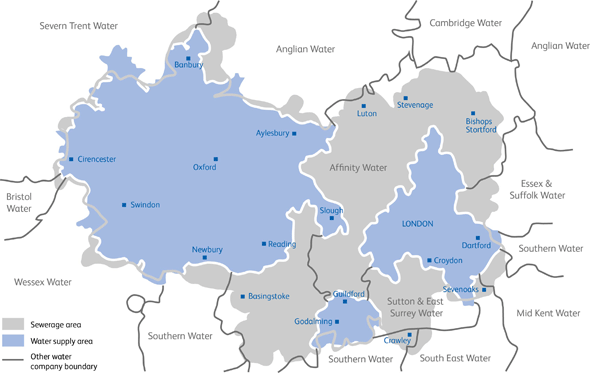Thames Water are the UK's largest water and wastewater services company, supplying ~2,600 million litres of tap water to 9 million customers across London and the Thames Valley and treating >4 billion litres of sewage for 15 million customers (Thames Water, 2020a).
 |
| Thames Water Supply Area (Thames Water, 2020a) |
Because Thames Water consists of the capital, they have some unique challenges, which could additionally be interpreted as opportunities for growth. I researched Thames Water before my visit and have added to this research with what I learned during my visit to their Reading Office as part of the Institute of Water Rising Stars 2020.
Challenge 1: Ageing Network
One challenge which the Thames Water area suffers greatly from is that of a Victorian era sewerage system. This system was designed for a maximum population of four million and would overflow into the Thames River only once or twice a year. This system is still operational however the population of London is now eight million, resulting in the overflow of sewage into the Thames on an almost weekly bases equating to millions of tonnes of sewage every year. These pollution incidences cause sickness of recreational users of the Thames as well as the deaths of thousands of fish (Thames Water, 2017a).
To mitigate this risk, a "super sewer" is being built, the Thames Tideway Tunnel, the biggest infrastructure project ever undertaken by the UK water industry. It is a 15-mile-long, seven meters wide (the width of three London buses), 65 meter deep tunnel under the River Thames. The consturction is being completed by a company called Tideway and is due to be finished in 2024 (Thames Water, 2017b).
 |
| Thames Tideway (Thames Water, 2017b) |
Challenge 2: Pipe Leakage
During the war, temporary fixes were put in place in the network when bomb damage occurred to ensure water supply was still present to stop fires. In some areas, these "quick fixes" are still in place, resulting in the leaks and burst pipes seen today (Aylard, 2020). In 2018/2019 690 millions of litres were leaked per day (Thames Water, 2020b). For scale, an Olympic-size swimming pool (50m x 25m x 2m) contains 2.5 million litres of water.
It is difficult to find these bursts because of the history of water supply. When water first came to London, it was not a united company but multiple independent companies in competition with each other. This means that in some locations there were, and still are, 8 lots of 36" mains in the same location (Aylard, 2020). This can make the mapping of pipes and the understanding of these complex networks very difficult, meaning leak detection can be more of a challenge than in other areas.
The 2020-2025 Thames Water business plan states aims of reducing leakage by 15% from the 2019/2020 target and replacing more than 700km of water pipes (Thames Water, 2019). It is difficult but leakage in the Thames Water area is something that is improving year by year as the older network is being replaced.
Challenge 3: London
London is a large city with eight million people and a diverse customer base (Thames Water, 2017a). This means that the Thames Water customer call centre takes 2000-3000 calls every day! Furthermore, ideas that would work in other locations such as tree planting to reduce carbon footprint may not be possible, given the urban environment.
One example of the difficulties of the city is that of fast food restaurants. There are a lot of fast food places in London, 8,622 takeaways, with Westminster alone having 464 fast-food outlets, the most per head of population than any other part of the country (Evening Standard, 2016). This quantity of restaurants puts the capital at risk with problems with fats, oils and greases (FOG) entering the drains. Although Thames Water clean their sewers yearly using contractors, problems occur. When FOG enters the sewage system and combines with things like unflushable wet wipes, nappies and cotton buds, something called a fatberg is formed. In 2019, Thames Water spent three weeks cleaning a 40-tonne fatberg the size of a double-decker bus from Greenwich, which was taking up 80% of the sewer’s capacity (The Guardian, 2019).
To help with this risk, Thames Water have a dedicated 8 person team who go to fast food companies and make sure they are properly disposing of their FOG. For example, they use an app called Arc Connector to see if a restaurant is being compliant with their advice (Glenton, 2020). This is being used in combination of a selection of GIS tools and models named I³, information, insight and intervention, to better map networks.
References
- Aylard, R. (2020), Personal Communications.
- Evening Stanard (2016), Mapped: every fast food outlet in London - as doctors warn of child obesity epidemic, https://www.standard.co.uk/news/london/mapped-every-fast-food-place-in-london-as-doctors-warn-of-child-obesity-epidemic-a3375116.html (Accessed: 18/03/20).
- Glenton, S (2020), Personal Communications.
- Thames Water (2017a), Why is the Thames Tideway Tunnel needed?, https://corporate.thameswater.co.uk/about-us/thames-tideway-tunnel/why-is-it-needed (Accessed: 18/03/20).
- Thames Water (2017b), What is the Thames Tideway Tunnel?, https://corporate.thameswater.co.uk/about-us/thames-tideway-tunnel/what-is-it, (Accessed: 18/03/20).
- Thames Water (2019), Our plan at a glance, https://corporate.thameswater.co.uk/-/media/Site-Content/Thames-Water/Corporate/AboutUs/Our-strategies-and-plans/PR19-April/Our-plan-at-a-glance---April-2019.pdf (Accessed: 18/03/20).
- Thames Water (2020a), Our supply area, https://corporate.thameswater.co.uk/about-us/our-business/our-supply-area (Accessed: 18/03/20).
- Thames Water (2020b), Our leakage performance, https://www.thameswater.co.uk/help-and-advice/leaks/our-leakage-performance, (Accessed: 18/03/20).
- The Guardian (2019), Bus-sized fatberg weighing 40 tonnes cleared from London sewer, https://www.theguardian.com/environment/2019/oct/29/bus-sized-fatberg-cleared-from-london-sewer (Accessed: 18/03/20).